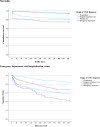Factors influencing hospitalization or emergency department visits and mortality in type 2 diabetes following the onset of new cardiovascular diagnoses in a population-based study
- PMID: 38600574
- PMCID: PMC11007935
- DOI: 10.1186/s12933-024-02211-4
Factors influencing hospitalization or emergency department visits and mortality in type 2 diabetes following the onset of new cardiovascular diagnoses in a population-based study
Abstract
Background: Individuals with type 2 diabetes (T2D) are at increased risk of developing cardiovascular disease (CVD) which necessitates monitoring of risk factors and appropriate pharmacotherapy. This study aimed to identify factors predicting emergency department visits, hospitalizations, and mortality among T2D patients after being newly diagnosed with CVD.
Methods: In a retrospective observational study conducted in Region Halland, individuals aged > 40 years with T2D diagnosed between 2011 and 2019, and a new diagnosis of CVD between 2016 and 2019, were followed for one year from the date of CVD diagnosis. The first encounter for CVD diagnosis was categorized as inpatient-, outpatient-, primary-, or emergency department care. Follow-up included laboratory tests, blood pressure, pharmacotherapies, and healthcare utilization. Hazard ratios (HR) in two Cox regression analyses determined relative risks for emergency visits/hospitalization and mortality, adjusting for age, sex, glucose regulation, lipid levels, kidney function, blood pressure, pharmacotherapy, and healthcare utilization.
Results: The study included a total of 1759 T2D individuals who received a new CVD diagnosis, with 67% diagnosed during inpatient care. The average hospitalization stay was 6.5 days, and primary care follow-up averaged 10.1 visits. Patients with CVD diagnosed in primary care had a HR 0.52 (confidence interval [CI] 0.35-0.77) for emergency department visits/hospitalization, but age had a HR 1.02 (CI 1.00-1.03). Pharmacotherapy with insulin, DPP4-inhibitors, aldosterone antagonists, and beta-blockers had a raised HR. Highest mortality risk was observed when CVD was diagnosed inpatient care, systolic blood pressure < 100 mm Hg and elevated HbA1c. Age had a HR 1.05 (CI 1.03-1.08), eGFR < 30 ml/min HR 1.46 (CI 1.01-2.11), and LDL-Cholesterol > 2,5 h 1.46 (CI 1.01-2.11) and associated with increased mortality risk. Pharmacotherapy with metformin had a HR 0.41 (CI 0.28-0.62), statins a HR 0.39 (CI 0.27-0.57), and a primary care follow-up < 30 days a HR 0.53 (CI 0.37-0.77) and associated with lower mortality risk.
Conclusions: T2D individuals who had a new diagnosis of CVD were predominantly diagnosed when hospitalized, while follow-up typically occurred in primary care. Identifying factors that predict risks of mortality and hospitalization should be a focus of follow-up care, underscoring the critical role of primary care in the effective management of T2D and CVD.
Keywords: Cardiovascular disease; Healthcare utilization; Mortality; Type 2 diabetes.
© 2024. The Author(s).
Conflict of interest statement
There are no competing interests to declare by the authors.
Figures
References
-
- International Diabetes Federation Diabetes around the World in. 2021. Available online: https://diabetesatlas.org/idfawp/resource-files/2021/11/IDFDA10-global-f....
-
- Emerging Risk Factors Collaboration. Sarwar N, Gao P, Seshasai SR, Gobin R, Kaptoge S, et al. Diabetes mellitus, fasting blood glucose concentration, and risk of vascular disease: a collaborative meta-analysis of 102 prospective studies. Lancet. 2010;375:2215–22. doi: 10.1016/S0140-6736(10)60484-9. - DOI - PMC - PubMed
Publication types
MeSH terms
LinkOut - more resources
Full Text Sources
Research Materials
Miscellaneous


